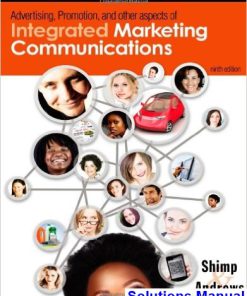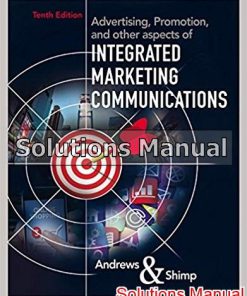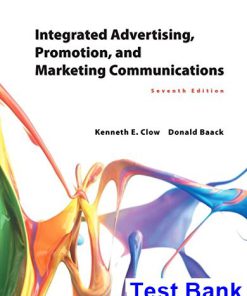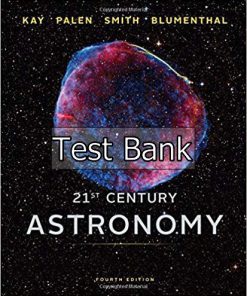Advertising Promotion and other aspects of Integrated Marketing Communications 10th Edition Andrews Test Bank
$26.50$50.00 (-47%)
Advertising Promotion and other aspects of Integrated Marketing Communications 10th Edition Andrews Test Bank.
You may also like
This is completed downloadable of Advertising Promotion and other aspects of Integrated Marketing Communications 10th Edition Andrews Test Bank
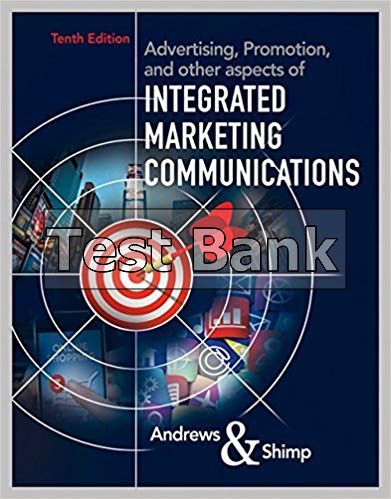
Product Details:
- ISBN-10 : 9781337282659
- ISBN-13 : 978-1337282659
- Author: J. Craig Andrews, Terence Shimp
Explore all aspects of marketing communications, from time-honored methods to the newest developments in the field backed by the latest research, data and analytic techniques with one of today’s leading IMC texts, ADVERTISING, PROMOTION, AND OTHER ASPECTS OF INTEGRATED MARKETING COMMUNICATIONS, 10E. With emphasis on the fundamentals and practices you need, this edition focuses on advertising and sales promotion, planning, branding, consumer behavior, media buying, public relations, packaging, POP communications, and personal selling. You explore emerging topics, such as today’s popularity of apps, social media outlets, online and digital practices, and viral communications, as well as their impact on traditional marketing. Revisions to this most current IMC text on the market address must-know changes to environmental, regulatory, and ethical issues; MindTap Insights Online; place-based applications; privacy; global marketing, and memorable advertising campaigns.
Table of Content:
- Part 1: The Practice and Environment of Integrated Marketing Communications (IMC)
- Chapter 1: An Overview of Integrated Marketing Communications
- Marcom Insight: Checking in with Mobile Apps: The Creative Use of Geo-Fencing and Geo-Conquesting
- Introduction
- Marketing Communications Objectives and Terminology
- Promotional Mix Elements
- The Primary Tools of Marketing Communications
- The Integration of Marketing Communications
- Why Integrate?
- IMC Practices and Synergy
- Definition of IMC
- Key Imc Features
- Key Feature #1: IMC Should Begin with the Customer or Prospect
- Key Feature #2: Use Any Form of Relevant Contact
- Key Feature #3: Speak with a Single Voice
- Key Feature #4: Build Relationships Rather Than Engage in Flings
- Key Element #5: Don’t Lose Focus of the Ultimate Objective: Affect Behavior
- Obstacles to Implementing the Key IMC Features
- The Marketing Communications Decision-Making Process
- Fundamental Marcom Decisions
- Marcom Implementation Decisions
- Marcom Outcomes
- Program Evaluation
- Summary
- Appendix
- Discussion Questions
- Chapter 2: Enhancing Brand Equity and Accountability
- Marcom Insight: Are There Too Many Social Media Brands?
- Introduction
- Brand Equity
- A Firm-Based Perspective on Brand Equity
- Brand Equity Models
- Relationships among Brand Concepts, Brand Equity, and Brand Loyalty
- Strategies to Enhance Brand Equity
- What Benefits Result from Enhancing Brand Equity?
- Characteristics of World-Class Brands
- Affecting Behavior and Achieving Marcom Accountability
- Difficulty of Measuring Marcom Effectiveness
- Assessing Effects with Marketing Mix Modeling
- Summary
- Discussion Questions
- Chapter 3: Brand Adoption, Brand Naming, and Intellectual Property Issues
- Marcom Insight: Goodwill Boutiques: Thrifty Brand Takes Off
- Introduction
- Marcom and Brand Adoption
- Brand Characteristics That Facilitate Adoption
- Quantifying the Adoption-Influencing Characteristics
- Brand Naming
- What Constitutes a Good Brand Name?
- The Brand-Naming Process
- The Role of Logos
- Intellectual Property
- Patents
- Copyrights
- Trademarks
- Summary
- Discussion Questions
- Chapter 4: Environmental, Regulatory, and Ethical Issues
- Marcom Insight: Graphic Visual Tobacco Warnings in the United States
- Introduction
- Environmental Marketing Communications
- Green Marketing Initiatives
- Social Media Campaigns
- Guidelines for Green Marketing
- Regulation of Marketing Communications
- When Is Regulation Justified?
- Regulation by Federal Agencies
- False Advertising and Lanham Act Cases in Federal Court
- Regulation by State Agencies
- Advertising Self-Regulation
- Ethical Issues in Marketing Communications
- The Ethics of Targeting
- Ethical Issues in Advertising
- Ethical Issues in Public Relations and Product Placement
- Ethical Issues in Packaging and Branding
- Ethical Issues in Sales Promotions
- Ethical Issues in Online and Social Media Marketing
- Fostering Ethical Marketing Communications
- Summary
- Discussion Questions
- Part 2: Fundamental IMC Planning and Decisions
- Chapter 5: Segmentation, Targeting, and Positioning
- Marcom Insight: Positioning and “McBucks”: Should McDonald’s Try to Become Starbucks?
- Introduction
- Segments and the Market Segmentation Process
- Segmentation Bases: Behavioral Segmentation
- Online Behavioral Targeting
- Privacy Concerns
- Psychographic Segmentation
- Customized Psychographic Profiles
- General Purpose Psychographic Profiles
- Geodemographic Segmentation
- Demographic Segmentation
- The Changing Age Structure
- The Ever-Changing American Household
- Ethnic Population Developments
- Market Targeting
- Market Positioning in Practice: The Fundamentals
- Benefit Positioning
- Attribute Positioning
- Repositioning a Brand
- Marketing Mix Development
- Summary
- Discussion Questions
- Chapter 6: The Communications Process and Consumer Behavior
- Marcom Insight: Everyday Consumer Habits Helping the World
- The Communications Process
- Elements in the Communication Process
- Marketing Communication and Meaning
- The Meaning of Meaning
- The Dimensions of Meaning
- Meaning Transfer: From Culture to Object to Consumer
- The Use of Figurative Language in Marketing Communications
- Behavioral Foundations of Marketing Communications
- The Consumer Processing Model (CPM)
- The Hedonic, Experiential Model (HEM)
- Summary
- Discussion Questions
- Chapter 7: The Role of Persuasion in Integrated Marketing Communications
- Marcom Insight: Can We Be Persuaded to Overcome Bad Habits? The Cell-Free Club
- The Nature and Role of Attitudes
- What Is an Attitude?
- Using Attitudes to Predict Behavior
- Persuasion in Marketing Communications
- The Ethics of Persuasion
- Tools of Influence: The Persuader’s Perspective
- Reciprocation
- Commitment and Consistency
- Social Proof
- Liking
- Authority
- Scarcity
- The Influence Process: The Persuadee’s Perspective
- Message Arguments
- Peripheral Cues
- Communication Modality
- Receiver Involvement
- Receiver’s Initial Position
- An Integrated Model of Persuasion
- The Central Route
- The Peripheral Route
- Dual Routes
- Enhancing Consumers’ Motivation, Ability, and pportunity to Process Advertisements
- Motivation to Attend to Messages
- Motivation to Process Messages
- Opportunity to Encode Information
- Opportunity to Reduce Processing Time
- Ability to Access Knowledge Structures
- Ability to Create Knowledge Structures
- Section Summary
- The Theory of Reasoned Action (Tora)
- Attitude Change Strategies
- Changing Preferences and Behavioral Modification Strategies
- Summary
- Discussion Questions
- Chapter 8: Objective Setting and Budgeting
- Marcom Insight: The Gecko, Flo, Mayhem, Magic Jingles, and the Insurance Industry Ad Brawl
- Introduction
- Setting Marcom Objectives
- The Hierarchy of Marcom Effects
- The Integrated Information Response Model
- Section Summary
- Requirements for Setting Suitable Marcom Objectives
- Should Marcom Objectives Be Stated in Terms of Sales?
- Marcom Budgeting
- Budgeting in Theory
- Budgeting in Practice
- Section Summary
- Summary
- Discussion Questions
- Part 3: Advertising Management and Media Choices
- Chapter 9: Overview of Advertising Management
- Marcom Insight: The Story of “Mad Man,” the “Elvis of Advertising”
- Introduction
- The Magnitude of Advertising
- Advertising-to-Sales Ratios
- Advertising Effects Are Uncertain
- Advertising’s Effect on the Economy
- Advertising = Market Power
- Advertising = Information
- A Synthesis
- Advertising Functions
- Informing
- Influencing
- Reminding and Increasing Salience
- Adding Value
- Assisting Other Company Efforts
- The Advertising Management Process
- Managing the Advertising Process: The Client Perspective
- The Role of Advertising Agencies
- Agency Compensation
- Ad-Investment Considerations
- The Case for Investing in Advertising
- The Case for Disinvesting
- Which Position Is More Acceptable?
- Summary
- Discussion Questions
- Chapter 10: Effective and Creative Ad Messages
- Marcom Insight: Perhaps the Greatest TV Commercial of All Time
- Introduction
- Suggestions for Creating Effective Advertising
- Qualities of Successful Advertising
- What Exactly Does Being “Creative” and “Effective” Mean?
- Creativity: The CAN Elements
- Getting Messages to “Stick”
- Illustrations of Creative and Sticky Advertising Executions
- Making an Impression
- Advertising Plans and Strategy
- A Five-Step Program
- Constructing a Creative Brief
- Advertising Objectives
- Target Audience
- Motivations, Thoughts, and Feelings
- Brand Positioning and Personality
- Primary Outcome or “Take Away”
- Other Details and Mandatories
- Means-End Chaining and Laddering
- The Nature of Values
- Which Values Are Most Relevant to Advertising?
- Advertising Applications of Means-End Chains: The MECCAS Model
- Identifying Means-End Chains: The Method of Laddering
- Practical Issues in Identifying Means-End Chains
- Alternative Styles of Creative Advertising
- Generic Creative Style
- Preemptive Creative Style
- Unique Selling Proposition Creative Style
- Brand Image Creative Style
- Resonance Creative Style
- Emotional Creative Style
- Section Summary
- Corporate Image and Corporate Issue Advertising
- Corporate Image Advertising
- Corporate Issue (Advocacy) Advertising
- Summary
- Discussion Questions
- Chapter 11: Endorsers and Message Appeals in Advertising
- Marcom Insight: When Celebrity Endorsers Go Bad
- Introduction
- The Role of Celebrity Endorsers in Advertising
- Source Attributes and Receiver Processing Modes
- Credibility: The Process of Internalization
- Attractiveness: The Process of Identification
- Power: The Process of Compliance
- Practical Issues in Selecting Celebrity Endorsers
- The Role of Q Scores
- The Role of Humor in Advertising
- Appeals to Consumer Fears
- Fear Appeal Logic
- Appropriate Intensity
- The Related Case of Appeals to Scarcity
- Appeals to Consumer Guilt
- The Use of Sex in Advertising
- What Role Does Sex Play in Advertising?
- The Potential Downside of Sex Appeals in Advertising
- Subliminal Messages and Symbolic Embeds
- Why It Is Unlikely That Subliminal Advertising Works
- The Functions of Music In Advertising
- The Role of Comparative Advertising
- Is Comparative Advertising More Effective?
- Considerations Dictating the Use of Comparative Advertising
- Summary
- Discussion Questions
- Chapter 12: Traditional Advertising Media
- Marcom Insight: Has Traditional Advertising Media Lost Its Effectiveness? The Rise of Cord Cutting,
- Introduction
- Some Preliminary Comments
- Newspapers
- Buying Newspaper Space
- Newspaper Advertising’s Strengths and Limitations
- Magazines
- Buying Magazine Space
- Magazine Advertising’s Strengths and Limitations
- Magazine Audience Measurement
- Using Simmons and MRI Reports
- Customized Magazines
- Radio
- Buying Radio Time
- Radio Advertising’s Strengths and Limitations
- Radio Audience Measurement
- Television
- Television Programming Dayparts
- Network, Spot, Syndicated, Cable, and Local Advertising
- Television Advertising’s Strengths and Limitations
- Infomercials
- Brand Placements in Television Programs
- Recent Developments in TV Advertising
- Television Audience Measurement
- Summary
- Discussion Questions
- Chapter 13: Digital Media: Online, Mobile, and App Advertising
- Marcom Insight: Mobile Headache? The Excitement and Challenges of Mobile Advertising
- Introduction
- Online Advertising: Benefits and Costs
- The Online Advertising Process
- Online Advertising Formats
- Search Engine Advertising
- Purchasing Keywords and Selecting Content-Oriented Websites
- SEA Problems and Suggestions
- Display Advertising
- Static Banner Ads
- Click-Through Rates
- Standardization of Display Ad Sizes
- Rich Media: Pop-Ups, Interstitials, Superstitials, and Online Video Ads
- Online Video Ads
- Mobile Advertising and Apps
- App Advertising
- Websites and Sponsored Sites
- Blogs and Podcasts
- Blogs
- Podcasts
- E-Mail Advertising
- Opt-in E-Mailing versus Spam
- E-Mail Magazines (E-zines)
- Behavioral Targeting, Programmatic Advertising, and Privacy Issues
- Behavioral Targeting
- Programmatic Ads
- Consumer Privacy
- Measuring Online Ad Effectiveness
- Metrics for Measuring Online Ad Performance
- Summary
- Discussion Questions
- Chapter 14: Social Media
- Marcom Insight: Is Facebook Becoming Passé? Or Are We Hopelessly Addicted?
- Introduction
- Social Media Background and Landscape
- Comparisons with Traditional Media
- Social Media Advantages and Disadvantages
- Social Media Categories and Brands
- Social Networking
- Snapchat
- Successful Social Media Campaigns
- Common Objectives and Themes for These Successful Social Media Campaigns
- Factors That “Work” in Social Media Campaigns and Why
- Organizing Social Media Efforts
- How to Advertise on Social Networks
- Privacy and Other Concerns
- Other Social Media Network Concerns
- Measurement of Social Media Campaigns
- Summary
- Discussion Questions
- Chapter 15: Direct Marketing, CRM, and Other Media
- Marcom Insight: During Tough Times, Flex Seal and ShamWow March On
- Introduction
- Direct Marketing
- Direct Marketing’s Phenomenal Growth
- Direct-Response Advertising
- Direct Mail
- Illustrations of Successful Direct-Mail Campaigns
- Direct Mail’s Distinctive Features
- Who Uses Direct Mail and What Functions Does It Accomplish?
- The Special Case of Catalogs and Video Media
- CRM and the Use of Databases
- Outbound and Inbound Telemarketing
- Outbound Telemarketing
- Inbound Telemarketing
- Major Telemarketing Regulation
- Other Media
- Brand Placements
- Brand Placements in Movies
- Brand Placements in TV Programs
- Yellow-Pages Advertising
- Video-Game Advertising
- Measuring Video-Game Audiences
- Cinema Advertising
- Alternative Advertising Media
- Summary
- Discussion Questions
- Chapter 16: Media Planning and Analysis
- Marcom Insight: Is Super Bowl Advertising Worth the Expense?
- Introduction
- Some Useful Terminology: Media versus Vehicles
- Messages and Media: A Hand-in-Glove Relation
- Programmatic Ad Buying
- Cross-Media Platforms
- Selecting and Buying Media and Vehicles
- The Media-Planning Process
- Selecting the Target Audience
- Specifying Media Objectives
- Reach
- Frequency
- Weight
- Continuity
- Recency Planning (a.k.a. the Shelf-Space Model)
- Cost Considerations
- The Necessity of Making Trade-Offs
- Media-Scheduling Software
- Hypothetical Illustration: A One-Month Magazine Schedule for the Esuvee Safety Campaign
- Review of Media Plans
- The Diet Dr Pepper Plan
- The FDA’s “The Real Cost” Campaign
- Summary
- Discussion Questions
- Chapter 17: Measuring Ad Message Effectiveness
- Marcom Insight: Lessons in Ad Copy Testing and Track-ing: The National Youth Anti-Drug Media Campaig
- Introduction to Advertising Research
- It Is Not Easy or Inexpensive
- Testing TV Commercials in Prefinished (Rough) Form
- What Does Advertising Research Involve?
- Industry Standards for Message Research
- What Do Brand Managers and Ad Agencies Want to Learn from Message Research?
- Two General Forms of Message Research
- Qualitative Message Research
- Quantitative Message Research
- Measures of Recognition and Recall
- Starch Ad Readership Studies
- Bruzzone Tests
- Day-After Recall Testing
- Measurement of Emotional Reactions
- BBDO’s Emotional Measurement System
- Facial Imaging Technology
- Neuroscience and Brain Imaging
- Self-Report Measurement
- Physiological Testing and Biometrics
- Measures of Persuasion
- The Ipsos ASI: Connect® Method
- The Ipsos ASI Next*TV® Method
- The MSW*ARS Brand Preference Method
- Measures of Sales Response (Single-Source Systems)
- Nielsen Catalina’s Advantics on Demand
- Some Major Conclusions about Television Advertising
- Conclusion 1—All Commercials Are Not Created Equal: Ad Copy Must Be Distinctive
- Conclusion 2—More Is Not Necessarily Better: Weight Is Not Enough
- Conclusion 3—All Good Things Must End: Advertising Eventually Wears Out
- Conclusion 4—Do Not Be Stubborn: Advertising Works Quickly or Not at All
- Summary
- Discussion Questions
- Part 4: Sales Promotion Management
- Chapter 18: Sales Promotion Overview and the Role of Trade Promotion
- Marcom Insight: The Latest in Trade Promotions: New Thinking and Old Ways
- Introduction
- The Nature of Sales Promotion
- Promotion Targets
- Increased Budgetary Allocations to Promotions
- Factors Accounting for the Shift
- A Consequence of the Increase: A Shift in Accounting Rules
- What Are Sales Promotions’ Capabilities and Limitations?
- What Promotions Can Accomplish
- What Promotions Cannot Accomplish
- Problems with an Excessive Emphasis on Sales Promotion
- The Role of Trade Promotions
- Trade Promotions’ Scope and Objectives
- Ingredients for a Successful Trade Promotion Program
- Trade Allowances
- Major Forms of Trade Allowances
- Undesirable Consequences of Off-Invoice Allowances: Forward Buying and Diverting
- Efforts to Rectify Trade Allowance Problems
- Category Management
- Everyday Low Pricing (EDLP)
- Pay-for-Performance Programs
- Customizing Promotions: Account-Specific Marketing
- Other Forms of Trade Promotions
- Generalizations about Promotions
- Generalization 1: Temporary Retail Price Reductions Substantially Increase Sales—But Only in the
- Generalization 2: The Greater the Frequency of Deals, the Lower the Height of the Deal Spike
- Generalization 3: The Frequency of Deals Changes the Consumer’s Reference Price
- Generalization 4: Retailers Pass through Less Than 100 Percent of Trade Deals
- Generalization 5: Higher-Market-share brands Are less deal elastic
- Generalization 6: Advertised promotions Can result in increased store Traffic
- Generalization 7: Feature advertising and displays operate synergistically to influence sales of dis
- Generalization 8: Promotions in one product category affect sales of brands in complementary and com
- Generalization 9: The effects of promoting higher- and lower-quality brands Are asymmetric
- Summary
- Discussion Questions
- Chapter 19: Consumer Sales Promotion: Sampling and Couponing
- Marcom Insight: Groupon: Is the “New” Model for Couponing Still Working?
- Introduction
- Why Use Consumer Promotions?
- Brand Management Objectives and Consumer Rewards
- Classification of Promotion Methods
- Sampling
- Major Sampling Practices
- When Should Sampling Be Used?
- Sampling Problems
- Couponing
- Couponing Background
- Point-of-Purchase Couponing
- Mail- and Media-Delivered Coupons
- In- and On-Pack Coupons
- Online and Social Group Couponing
- The Coupon Redemption Process and Misredemption
- The Role of Promotion Agencies
- The Rise of the Online Promotion Agency
- Summary
- Discussion Questions
- Chapter 20: Consumer Sales Promotion: Premiums and Other Promotions
- Marcom Insight: Whopper Sacrifice: is an Online Premium Offer Worth 10 Friends?
- Introduction
- Premiums
- Free-with-Purchase Premiums
- Mail-In and Online Offers
- In-, On-, and Near-Pack Premiums
- Self-Liquidating Offers
- What Makes a Good Premium Offer?
- Price-Offs
- Federal Trade Commission Price-Off Regulations
- Bonus Packs
- Games
- Avoiding Snafus
- Refunds and Rebates
- Phantom Discounts
- Rebate Fraud
- Sweepstakes and Contests
- Sweepstakes
- Contests
- Online Sweeps and Contests
- Continuity Promotions
- Overlay and Tie-In Promotions
- Overlay Programs
- Tie-In Promotions
- Retailer Promotions
- Retail Coupons
- Frequent-Shopper (Loyalty) Programs
- Special Price Deals
- Samples, Premiums, and Games
- Evaluating Sales Promotion Ideas
- A Procedure for Evaluating Promotion Ideas
- Postmortem Analysis
- Summary
- Discussion Questions
- Part 5: Other IMC Tools
- Chapter 21: Public Relations, Content Marketing, Viral Marketing, and Sponsorships
- Marcom Insight: Rats and False Eight-Legged Chicken Rumors: KFC/Taco Bell Restaurants
- Introduction
- Marketing Public Relations (MPR) versus Advertising
- Proactive versus Reactive Mpr
- Proactive MPR
- Content Marketing
- Reactive MPR
- Crisis Management
- The Special Case of Rumors and Urban Legends
- What Is the Best Way to Handle a Rumor?
- Word-of-Mouth Influence
- Strong and Weak Ties
- The Role of Opinion Leaders in WOM Dissemination
- Prevent Negative WOM
- Viral Marketing
- Viral Marketing Is Akin to Creating an Epidemic
- Some Anecdotal Evidence
- Formal Perspectives on Buzz Creation
- Igniting Explosive Self-Generating Demand
- Summing Up
- Sponsorship Marketing
- Event Sponsorships
- Selecting Sponsorship Events
- Sponsorship Agreements
- Creating Customized Events
- Ambushing Events
- Measuring Success
- Cause Sponsorships
- The Benefits of Cause-Related Marketing
- The Importance of Fit and Community-Driven CRM Efforts
- Accountability Is Critical
- Summary
- Discussion Questions
- Chapter 22: Packaging, Point-of-Purchase Communications, and Signage
- Marcom Insight: The “Appification” of Grocery Shopping
- Introduction
- Packaging
- Packaging Structure
- Evaluating the Package: The VIEW Model
- Quantifying the VIEW Components
- Designing a Package
- Point-of-Purchase (POP) Communications
- The Spectrum of POP Materials
- What Does POP Accomplish?
- POP’s Influence on Consumer Behavior
- Evidence of In-Store Decision Making
- Evidence of Display Effectiveness
- Latest POPAI Research
- The Use and Nonuse of POP Materials
- Measuring In-Store Advertising’s Audience
- On-Premise Business Signage
- Types of On-Premise Signs
- The ABCs of On-Premise Signs
- Seek Expert Assistance
- Out-of-Home (OOH, Off-Premise) Advertising
- Forms of Billboard Ads
- Buying Billboard Advertising
- Billboard Advertising’s Strengths and Limitations
- Measuring Billboard Audience Size and Characteristics: OAAA’s Geopath Ratings
- A Case Study of Billboard Effectiveness
- Other Forms of OOH Advertising
- Summary
- Discussion Questions
- Chapter 23: Personal Selling
- Marcom Insight: What Qualities Are Liked and Disliked in a Salesperson?
- Introduction
- Personal Selling
- Personal Selling’s Role in the Promotion Mix and IMC
- Attitudes Toward Selling
- Attractive Features of Personal Selling
- Modern Selling Philosophy
- Selling Activities and Types of Personal-Selling Jobs
- Selling Activities
- Types of Sales Jobs
- The Basic Steps in Personal Selling
- Step 1: Prospecting and Qualifying
- Step 2: Preapproach
- Step 3: Approach
- Step 4: The Sales Presentation
- Step 5: Handling Objections
- Step 6: The Close
- Step 7: The Follow-Up
- In Summary
- Salesperson Performance and Effectiveness
- Specific Determinants of Salesperson Performance
- Excellence in Selling
- Specific Characteristics of High-Performers
- Summary
- Discussion Questions
- Glossary
- End Notes
- Name Index
- Subject Index
People Also Search:
advertising promotion and other aspects of integrated marketing communications
advertising promotion and other aspects of integrated marketing communications 10th edition
advertising promotion and other aspects of integrated marketing communications download scribd
advertising promotion and other aspects of integrated marketing communications testbank download pdf




